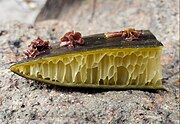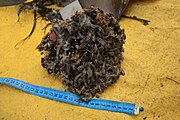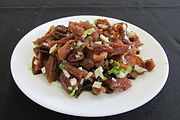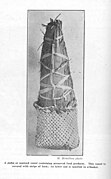Durvillaea
| Durvillaea | |
|---|---|

| |
| Durvillaea antarctica and D. willana on Taieri Island | |
| Scientific classification | |
| Domain: | Eukaryota |
| Clade: | Diaphoretickes |
| Clade: | SAR |
| Clade: | Stramenopiles |
| Phylum: | Gyrista |
| Subphylum: | Ochrophytina |
| Class: | Phaeophyceae |
| Order: | Fucales |
| Family: | Durvillaeaceae (Oltmanns) De Toni |
| Genus: | Durvillaea Bory |
| Type species | |
| D. antarctica | |
| Species | |
|
See text | |
Durvillaea is a genus of large brown algae in the monotypic family Durvillaeaceae. All members of the genus are found in the southern hemisphere, including Australia, New Zealand, South America, and various subantarctic islands.[2][3] Durvillaea, commonly known as southern bull kelps, occur on rocky, wave-exposed shorelines and provide a habitat for numerous intertidal organisms.[4][5] Many species exhibit a honeycomb-like structure in their fronds that provides buoyancy, which allows individuals detached from substrates to raft alive at sea, permitting dispersal for hundreds of days over thousands of kilometres.[3][6][7] Durvillaea species have been used for clothing, tools and as a food source by many indigenous cultures throughout the South Pacific, and they continue to play a prominent role in Chilean cuisine.[3]
Common name and etymology
The common name for Durvillaea is southern bull kelp, although this is often shortened to bull kelp, which can generate confusion with the North Pacific
The genus is named after French explorer Jules Dumont d'Urville (1790-1842).[10]
Description

Durvillaea species are
Durvillaea species are characterised by their prolific growth and plastic morphology.[13]
Three species,
Ecology
Durvillaea bull kelp grow within intertidal and shallow subtidal areas, typically on rocky wave-exposed coastal sites.[13] D. antarctica and D. poha are intertidal, whereas D. willana is subtidal (to 6 m depths).[16] Intertidal species can grow at the uppermost limit of the intertidal zone if there is sufficient wave wash.[17] Species can withstand a high level of disturbance from wave action,[13] although storms can remove individuals from substrates.[18][19][20]
Research on the bacteria associated with Durvillaea indicates that local environmental conditions shape external microbiome diversity significantly.[21] Further research suggests that the diversity of bacterial microbiomes associated with D. antarctica is influenced by the density and connectivity of the host kelp populations.[22]
-
-
D. antarctica growing at Boom Rock, Wellington
-
D. antarctica at Manurewa Point, in the Wairarapa
-
D. fenestrata growing in the Antipodes Islands
-
Durvillaea kelp on Enderby Island
Epibionts, parasites and rafting

Holdfasts of
Durvillaea individuals can detach from substrates, particularly during storms. Once detached, buoyant species such as D. antarctica and D. poha can float as rafts, and can travel vast distances at sea, driven by ocean currents.[6][7] Specimens of D. antarctica have been found to float for up to 210 days, during which time high wind speeds transport kelp rafts up to 10,000 km.[6][7] Environmental factors such as temperature, solar radiation and surface winds (all of which vary with latitude) affect buoyancy of southern bull kelp rafts and their rate of travel.[6] Rafts of D. antarctica are more likely to disperse offshore if individuals detach during outgoing tides during autumn and winter.[27] Rafts of Kelp-associated invertebrates inside holdfasts and external epiphytes can be transported by rafting individuals, potentially leading to long-distance dispersal and a significant impact upon the population genetic structure of the invertebrate species.[18][19][12][20][23][24] Attached male and female individuals can raft together, providing an opportunity for reproduction.[11][12] Rafts of D. antarctica currently reach Antarctica,[28][7] although freezing negative impacts the buoyancy and photosynthetic activity of D. antarctica tissue, which may affect the viability and reproductive capability of rafts.[29]
Rafts of Durvillaea can be colonised by the goose barnacles Lepas australis and L. pectinata. Beachcast, decomposing bull-kelp is colonised and consumed by a wide variety of invertebrates including sandhoppers Bellorchestia quoyana,[30] and kelp flies Chaetocoelopa littoralis.
Other seaweeds including Gelidium lingulatum, G. rex, Corallina officinalis var. chilensis, and Lessonia spicata also grow as epiphytes in the holdfasts of D. antarctica.[31] Rafting on D. antarctica appears to have influenced the dispersal and phylogeography of these non-buoyant species.[31][32] In New Zealand, Durvillaea fronds can also be infected by the obligate red algal epiphyte Pyrophyllon subtumens (J. Agardh ex R.M. Laing) W.A. Nelson 2003.[33][34]
Fronds of
-
Cross-section of a D. antarctica frond, showing Pyrophyllon subtumens growing on the outer surface
-
-
Beachcast D. antarctica kelp frond with blisters caused by an infection
-
A detached holdfast of D. antarctica found off Chile, colonised by the goose barnacle Lepas australis
Environmental stressors
Increased temperatures and heatwaves, increased sedimentation, and invasive species (such as
A marine heatwave in the summer of 2017/18 appears to have caused the local extinction of multiple Durvillaea species at Pile Bay, on the Banks Peninsula.[42] Once the kelp was extirpated, the invasive kelp Undaria pinnatifida recruited in high densities.[42]
Disturbance from earthquake uplift
Earthquake uplift that raises the intertidal zone by as little as 1.5 metres can cause Durvillaea bull kelp to die off in large numbers.[15][43][44] Increased sedimentation following landslides caused by earthquakes is also detrimental.[43][44] Once an area is cleared of Durvillaea following an uplift event, the bull kelp that re-colonises the area can potentially originate from genetically distinct populations far outside the uplift zone, spread via long distance-dispersal.[45]
Intertidal species of Durvillaea can be used to estimate earthquake uplift height, with comparable results to traditional methods such as lidar.[17] However, since Durvillaea holdfasts often grow at the uppermost limit of the intertidal zone, these uplift estimates are slightly less accurate compared to measures derived from other intertidal kelp such as Carpophyllum maschalocarpum.[17]
Chile
The 2010 Chile earthquake caused significant coastal uplift (~0.2 to 3.1 m), particularly around the Gulf of Arauco, Santa María Island and the Bay of Concepción.[46] This uplift caused large scale die offs of D. antarctica and dramatically affected the intertidal community.[46] The damage to infrastructure and ecological disturbance caused by the earthquake was assessed to be particularly damaging for seaweed gatherers and cochayuyo harvest.[47]
New Zealand
Akatore
Duvillaea bull kelp diversity appears to have been affected by uplift along the
Kaikōura
A substantial die off of Durvillaea bull kelp occurred along the
A genetic analysis indicated that some of the Durvillaea that subsequently reached the affected coastline (i.e. potential colonists) came from areas >1,200 kilometres away.[45] For another study, researchers sampled dying D. antarctica immediately after the earthquake to capture the 'pre-uplift' population genomic diversity and they subsequently sampled new recruits of D. antarctica within the newly formed intertidal zone to estimate 'post-uplift' population structure.[49] Population genomic analysis indicated little change in genetic diversity within four years of recolonisation by D. antarctica.[49] Based on those genomic results, combined with field observations of the recovery of Durvillaea throughout the uplift zone, and oceanographic connectivity modelling, it was hypothesised that the surviving populations of D. antarctica (typically sparse and lower within the intertidal zone) have dominated the early recolonisation.[49] The researchers argued that the newly formed coastline has not yet been fully recolonised though, and the population structure and genomic diversity of D. antarctica in the Kaikōura region is likely to change over coming decades.[49]
A genetic study investigated bacteria associated with D. antarctica and found that the 2016 earthquake changed the diversity of the microbiome in disturbed, uplifted populations.[22] Specifically, the analysis showed that disturbed bull kelp populations supported higher functional, taxonomic and phylogenetic microbial beta diversity than non-disturbed populations.[22] It was hypothesised that this change was induced by the sudden decline in the host D. antarctica population following the earthquake.[22]
Rārangi
The D. antarctica sampled from
Wellington and the Wairarapa
Based on genetic data, the predominantly southern-restricted species
A genetic study of D. antarctica identified distinct units of population structure across the uplift zone of the 1855 Wairarapa earthquake.[53] Notably, two spatial-genomic sectors of D. antarctica were identified on Turakirae Head, which received the greatest degree of uplift (2 – 6 m).[53] Phylogeographic modelling indicated that bull kelp that survived moderate uplift in the Wellington region (≤2 m) likely recolonised Turakirae Head via two parallel, eastward colonisation events - resulting in the two observed units of population structure.[53] The hierarchical phylogeographic variation observed in the study provided non-experimental evidence of parapatric sectoring (see Founder takes all) as a result of natural disturbance, over a timescale observable to humans (i.e. <200 years).[53]
It has been hypothesised that gaps in the current geographic range of
-
A die off of exposed Durvillaea kelp following uplift caused by the 2016 Kaikoura earthquake
-
Durvillaea kelp and other seaweeds exposed by earthquake uplift at Kaikoura
-
Uplifted shoreline at Ward Beach (photographed in 2020), with D. antarctica growing in the new intertidal zone
-
D. antarctica on Turakirae Head, with the raised beach in the background
Species and distribution
There are currently eight recognised species within the genus, and the type species is D. antarctica.[1] All species are restricted to the Southern Hemisphere and many taxa are endemic to particular coastlines or subantarctic islands.
- Durvillaea amatheiae X.A. Weber, G.J. Edgar, S.C. Banks, J.M. Waters & C.I. Fraser, 2017,[54] endemic to southeast Australia.[3][54]
- Durvillaea antarctica (Chamisso) Hariot,[1] found in New Zealand, Chile and various subantarctic islands including Macquarie Island.[2][30][3][9][13][14][48][51][53][55][56]
- Durvillaea chathamensis C.H.Hay, 1979,[56] endemic to the Chatham Islands.[3][9]
- Durvillaea fenestrata C. Hay, 2019,[3] endemic in the subantarctic Antipodes Islands.[3][9]
- Durvillaea incurvata (Suhr) Macaya,[3] endemic to Chile.[3]
- Durvillaea potatorum (Labillardière) Areschoug, endemic to southeast Australia.[8][9][57]
Evolution
Time-calibrated
A phylogeny focused on the genus, based on four genes (COI, rbcL, 28S and 18S) indicates the evolutionary relationships shown in the cladogram below.[3][9] Notably, additional unclassified lineages were estimated within D. antarctica.[3][9] Mitochondrial introgression has been observed between two species, where some individuals with nuclear DNA of D. poha exhibited mitochondrial DNA belonging to D. antarctica.[52]
|
Use of Durvillaea species
Australia
D. potatorum was used extensively for clothing and tools by Aboriginal Tasmanians, with uses including material for shoes and bags to transport freshwater and food.[61][62] Currently, D. potatorum is collected as beach wrack from King Island, where it is then dried as chips and sent to Scotland for phycocolloid extraction.[63]
Chile
D. antarctica and D. incurvata have been used in Chilean cuisine for salads and stews, predominantly by the Mapuche indigenous people who refer to it as collofe or kollof.[3][64] The same species is also called cochayuyo (cocha: lake, and yuyo: weed), and hulte in Quechua.[3][47][65] The kelp harvest, complemented with shellfish gathering, supports artisanal fishing communities in Chile.[65] Exclusive harvest rights are designated using coves or caletas, and the income for fishers (and their unions) often depends upon the sale of cochayuyo.[65]
New Zealand
Māori use D. antarctica (rimurapa) and D. poha to make traditional pōhā bags, which are used to transport food and fresh water, to propagate live shellfish, and to make clothing and equipment for sports.[66][67][68] Pōhā are especially associated with Ngāi Tahu and are often used to carry and store muttonbird (tītī) chicks.[66][67] The Ngai Tahu Claims Settlement Act 1998 protects Durvillaea bull kelp from commercial harvesting within the tribe's traditional seaweed-gathering areas.[69]
People living in coastal Otago and Southland have also traditionally carved bouncing balls, including
-
Cochayuyo (D. antarctica) for sale in Chile
-
Cochayuyo salad
References
- ^ a b c Bory de Saint-Vincent, J.B.G.M. (1826). Laminaire, Laminaria. In: Dictionnaire Classique d'Histoire Naturelle. (Audouin, I. et al. Eds) Vol. 9, pp. 187-194.
- ^ hdl:10092/5690.
- ^ PMID 31642057.
- ^ hdl:10092/15095.
- ^ S2CID 239888553.
- ^ S2CID 173993590.
- ^ S2CID 249478074.
- ^ S2CID 83670142.
- ^ PMID 20971197.
- ISBN 978-1-876268-33-6.
- ^ .
- ^ .
- ^ a b c d "Kelp". Australian Antarctic Division: Leading Australia’s Antarctic Program. Department of the Environment and Energy. Retrieved 7 December 2016.
- ^ S2CID 86386681.
- ^ S2CID 208593399.
- ^ PMID 32635859.
- ^ .
- ^ .
- ^ PMID 23134782.
- ^ .
- .
- ^ .
- ^ S2CID 84574097.
- ^ .
- ISSN 0301-4223.
- ^ Vink, C., McQuillan, B., Simpson, A., & Correa-Garhwal, S. (2017). The marine spider, Desis marina (Araneae: Desidae): new observations and localities. The Weta, 51, 71-79. Retrieved from http://publications.ento.org.nz/index.php/weta/article/view/167 Archived 2019-12-20 at the Wayback Machine
- .
- .
- .
- ^ S2CID 84692284.
- ^ ISBN 978-94-017-7534-2.
- S2CID 253770571.
- S2CID 85007306.
- S2CID 83609962.
- .
- ^ S2CID 21397549.
- ^ hdl:1885/238283.
- PMID 28822911.
- ^ ISSN 0025-3162.
- ^ Baranuik, Chris (5 April 2021). "Kelp Pathogen Has Spread Across the Southern Ocean". The Scientist. Retrieved 14 April 2021.
- .
- ^ .
- ^ S2CID 195403585.
- ^ a b c d "Kelp forests after the Kaikoura Earthquake". Science Learning Hub. 23 January 2020. Retrieved 21 February 2020.
- ^ PMID 31711270.
- ^ .
- ^ .
- ^ S2CID 189974346.
- ^ .
- .
- ^ PMID 37194268.
- ^ PMID 33942304.
- ^ PMID 35582778.
- ^ a b Weber, X.A., Edgar, G.J., Banks, S.C., Waters, J.M., and Fraser, C.I. "A morphological and phylogenetic investigation into divergence among sympatric Australian southern bull kelps (Durvillaea potatorum and D. amatheiae sp. nov.)." Mol. Phylogenet. Evol. (2017) 107:630-643.
- ^ S2CID 18309093.
- ^ .
- .
- ^ a b Lindauer, V.W. (1949). "Notes on marine algae of New Zealand. I". Pacific Science. 3: 340–352.
- PMID 20412862.
- S2CID 84955971.
- .
- ^ Murtough, Harry (6 January 2019). "Kelp water carrying sculptures mad by Nannette Shaw win Victorian Aboriginal art award". The Examiner. Retrieved 10 July 2020.
- ^ Kelp Industries (August 2004). "Proposal for the harvest and export of native flora under the Environment Protection and Biodiversity Conservation Act 1999" (PDF).
- ^ Stuart, Jim (15 April 2010). "Seaweed: Cochayuyo and Luche". Eating Chilean.
- ^ S2CID 17720219.
- ^ a b "Page 4. Traditional use of seaweeds". Te Ara: The Encyclopedia of New Zealand. 12 Jun 2006. Retrieved 19 November 2019.
- ^ Museum of New Zealand Te Papa Tongarewa. 30 May 2016. Retrieved 21 November 2019.
- ^ "Maori shellfish project wins scholarship". SunLive. 13 May 2018. Retrieved 26 November 2019.
- ^ "Durvillaea antarctica". New Zealand Plant Conversation Network. 10 July 2020. Retrieved 10 July 2020.
- ^ Lovell-Smith, Melanie (12 Jun 2006). "Maggy Wassilieff, 'Seaweed - Kelp', Te Ara - the Encyclopedia of New Zealand: Kelp Ball". Te Ara: The Encyclopedia of New Zealand. Retrieved 3 January 2021.
- ^ "Rakiura Stewart Island, From Nine To Noon 31 August 2009: Off the beaten track on Rakiura Stewart Island". Radio New Zealand. 31 August 2009. Retrieved 3 January 2021.
Further reading
- Adams, N.M. (1994). Seaweeds of New Zealand. Canterbury University Press. ISBN 978-0908812219.
- Morton, J.W.; Miller, M.C. (1973). The New Zealand Seashore. Collins.
External links
- Algaebase: Durvillaea Bory, 1826
- Museum of New Zealand Te Papa Tongarewa: Durvillaea (Genus)
- Critter of the Week NZ Bull Kelp (Critter of the Week)















